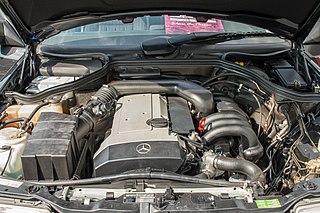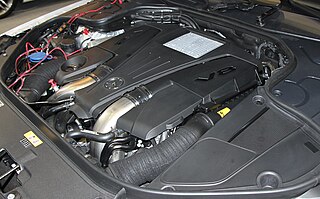
A turbocharger, formally a turbosupercharger and colloquially known as turbo, is a turbine-driven, forced induction device that increases an internal combustion engine's power output by forcing extra compressed air into the combustion chamber. This improvement over a naturally aspirated engine's power output is because the compressor can force more air—and proportionately more fuel—into the combustion chamber than atmospheric pressure alone.

A gas turbine, also called a combustion turbine, is a type of continuous and internal combustion engine. The main elements common to all gas turbine engines are:
Forced induction is the process of delivering compressed air to the intake of an internal combustion engine. A forced induction engine uses a gas compressor to increase the pressure, temperature and density of the air. An engine without forced induction is considered a naturally aspirated engine.

Garrett Motion Inc., formerly Honeywell Transportation Systems and Honeywell Turbo Technologies, is an American company primarily involved in engineering, development and manufacturing of turbochargers and related forced induction systems for ground vehicles from small passenger cars to large trucks and industrial equipment and construction machinery. It originated as part of Garrett AiResearch's Industrial Division in Phoenix, Arizona in 1954, after which they entered a contract to provide 5,000 turbochargers for the Caterpillar mining vehicle. It manufactured turbochargers for railroads and commercial trucks. The business produced approximately $3.6 billion in revenue in 2021. Garrett Motion is also involved in motorsports providing turbochargers and forced induction systems, solutions and related equipment to racing teams and various forms of automobile racing and professional competitions. In 2004, the business became part of American industrial conglomerate Honeywell International, Inc., as their Transportation Systems division. In 2018, it was spun off to become an independent company under the Garrett Motion name with corporate headquarters in Rolle, Switzerland.
Mercedes-AMG GmbH, commonly known as AMG, is the high-performance subsidiary of Mercedes-Benz AG. AMG independently hires engineers and contracts with manufacturers to customize Mercedes-Benz AMG vehicles. The company has its headquarters in Affalterbach, Baden-Württemberg, Germany.

Brabus GmbH is a German high-performance automotive aftermarket tuning company founded in 1977 in Bottrop. Brabus specialises in Mercedes-Benz, Smart and Maybach vehicles, although in 2022 it also tuned 2 Porsches and even a Rolls-Royce. Brabus is the largest Mercedes-Benz tuner after Mercedes-AMG, which has been a Daimler AG subsidiary since the 1990s.

The Mercedes-Benz M104 is a straight-6 automobile engine produced from 1989 through 1999. It has a double overhead cam design with 4 valves per cylinder, and used a crossflow cylinder head. It replaced the M103 and was replaced by the M112 V6 starting in 1997. The M104 continued in production until 1999 where its last use by Mercedes-Benz was in the W140 chassis. The bore spacing on all M104 engines is the same as the M103 engine. Also donated cast iron moldings to Toyota 1FZ production at 97 mm.
The anti-lag system (ALS) is a method of reducing turbo lag or effective compression used on turbocharged engines to minimize turbo lag on racing or performance cars. It works by delaying the ignition timing and adding extra fuel to balance an inherent loss in combustion efficiency with increased pressure at the charging side of the turbo. This is achieved as an excess amount of fuel/air mixture escapes through the exhaust valves and combusts in the hot exhaust manifold spooling the turbocharger creating higher usable pressure.

Variable-geometry turbochargers (VGTs), occasionally known as variable-nozzle turbines (VNTs), are a type of turbochargers, usually designed to allow the effective aspect ratio of the turbocharger to be altered as conditions change. This is done with the use of adjustable vanes located inside the turbine housing between the inlet and turbine, these vanes affect flow of gases towards the turbine. The benefit of the VGT is that the optimum aspect ratio at low engine speeds is very different from that at high engine speeds.
Twincharger refers to a compound forced induction system used on some piston-type internal combustion engines. It is a combination of an exhaust-driven turbocharger and a mechanically driven supercharger, each mitigating the weaknesses of the other. A mechanically driven supercharger offers exceptional response and low-rpm performance as it does not rely on pressurization of the exhaust manifold. A turbocharger sized to move a large volume of air tends to respond slowly to throttle input while a smaller, faster-responding turbo may fail to deliver sufficient volume through an engine's upper RPM range. The unacceptable lag time endemic to a large turbocharger is effectively neutralized when combined with a supercharger which tends to generate substantial boost pressure much faster in response to throttle input. The end result being a zero-lag powerband with high torque at lower engine speeds and increased power at the upper end. Twincharging is therefore desirable for small-displacement motors, especially those with a large operating rpm, since they can take advantage of an artificially broad torque band over a large speed range.
Twin-turbo refers to an engine in which two turbochargers compress the intake fuel/air mixture. The most common layout features two identical or mirrored turbochargers in parallel, each processing half of a V engine's produced exhaust through independent piping. The two turbochargers can either be identical or different sizes.
Mild hybrids are generally cars with an internal combustion engine equipped with an electric machine allowing the engine to be turned off whenever the car is coasting, braking, or stopped, yet restart quickly. Mild hybrids may employ regenerative braking and some level of power assist to the internal combustion engine (ICE), but mild hybrids do not have an electric-only mode of propulsion.

The term turbo-diesel, also written as turbodiesel and turbo diesel, refers to any diesel engine equipped with a turbocharger. As with other engine types, turbocharging a diesel engine can significantly increase its efficiency and power output, especially when used in combination with an intercooler.

In an internal combustion engine, a supercharger compresses the intake gas, forcing more air into the engine in order to produce more power for a given displacement.

G-Power is a German car tuning manufacturer based in Aichach, Bavaria. Founded in 1983 by Jochen Grommisch, the company specialises in tuning BMW cars and manufacturing boutique vehicles. Its supercharged 5.0L V-10 830 hp BMW M5 Hurricane RR reached 372 km/h (231 mph)
An electric supercharger is a specific type of supercharger for internal combustion engines that uses an electrically powered forced-air system that contains an electric motor to pressurize the intake air. By pressurizing the air available to the engine intake system, the air becomes more dense, and is matched with more fuel, producing the increased horsepower to the wheels.

The Mercedes-Benz M278 is a family of direct injected, Bi-turbocharged, V8 gasoline automotive piston engines.

Kompressor is a marketing name for forced induction (supercharged) Mercedes-Benz engines. The term is not widely used by other motor manufacturers.

The M176/M177/M178 is a V8 petrol engine range designed by Mercedes-AMG, replacing Mercedes-Benz M278 engine and Mercedes-Benz M157 engine, and is based on the Mercedes-AMG M133.

The Mercedes-AMG GT 4-Door Coupé is an executive car introduced in 2018 by Mercedes-AMG marketed as a five-door variant of the AMG GT two-door sports car.













